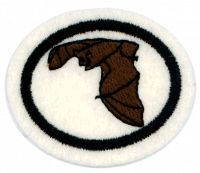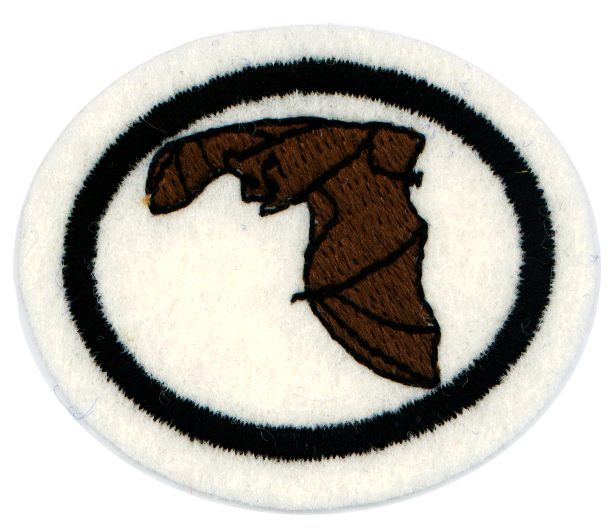Difference between revisions of "AY Honors/Bats/Answer Key/es"
(Created page with "{{clear}}") |
(Created page with "<noinclude>") |
||
| Line 90: | Line 90: | ||
</div> | </div> | ||
| − | + | * '''b. Micro-quirópteros:''' Usan la ecolocalización. (Los murciélagos emiten ondas de sonido usando la boca o la nariz. Cuando el sonido choca contra un objeto un eco regresa. El murciélago puede identificar un objeto por el sonido del eco. Incluso pueden saber al tamaño, la forma y la textura de un pequeño insecto de su eco. La mayoría de los murciélagos usan la ecolocalización para navegar en la oscuridad y encontrar comida.) | |
| − | *'''b. | ||
| − | |||
| − | + | <noinclude></noinclude> | |
| − | <noinclude | ||
| − | |||
{{CloseReq}} <!-- 7 --> | {{CloseReq}} <!-- 7 --> | ||
{{ansreq|page={{#titleparts:{{PAGENAME}}|2|1}}|num=8}} | {{ansreq|page={{#titleparts:{{PAGENAME}}|2|1}}|num=8}} | ||
| Line 105: | Line 101: | ||
</div> | </div> | ||
| − | + | <noinclude></noinclude> | |
| − | <noinclude | ||
| − | |||
{{CloseReq}} <!-- 8 --> | {{CloseReq}} <!-- 8 --> | ||
{{ansreq|page={{#titleparts:{{PAGENAME}}|2|1}}|num=9}} | {{ansreq|page={{#titleparts:{{PAGENAME}}|2|1}}|num=9}} | ||
Revision as of 04:07, 5 April 2021
| Tip for earning from home during the pandemic | |
| To earn requirement 16 you will need tools and building materials. If you have access to these, it is possible to earn this one from home. |
1
Aquí hay algunos identificadores para mamíferos, pájaros y murciélagos. Después de examinar la lista, debería ser bastante obvio cuánto más son los murciélagos como los mamíferos:
Mamíferos:
- Pelo
- Dan a luz a crías vivas (menos el ornitorrinco)
- Los bebés amamantan de la madre
- Sangre caliente
- Cuatro patas usualmente con dedos en los pies y/o «manos» y «pies»
Murciélagos:
- Tienen pelo
- Un bebé murciélago nace vivo
- Los bebés amamantan de la madre
- Tienen sangre caliente
- Los murciélagos tienen brazos, manos y patas
Aves:
- Las aves tienen plumas, no pelo
- Salen de huevos
- Los bebés se alimentan desde la boca de la madre
- Tienen alas, pero no manos ni dedos
2
Los murciélagos son los «únicos» mamíferos que realmente pueden volar (otras especies tales como las ardillas voladoras en realidad se deslizan en vez de volar).
3
Bats are in the order Chiroptera, which literally means "hand-wing" in Latin. This name makes sense because a bat's wings stretch over the forearm and fingers, and attach down at the ankle bones. The name is from the Greek, Cheir=hand; Pteron=wing. They got this name when scientists noticed that they fly with a modified hand.
4
- Largest: The biggest flying mammals are the Flying Foxes, particularly those living in Asia and Australia. Several species have a length of 45 cm (17.7 in), a wingspan of 1.7 m (5 ft 7 in), and a weight of 1.6 kg (3.5 lb). The Indian Flying Fox in particular has been known to attain a wingspan of 6 feet.
- Smallest: The world's smallest bat is the Kitti's Hog-Nosed Bat (a.k.a. The Bumblebee Bat) of Thailand. Weighing less than a penny and with a wingspan of less than 5 inches it is also the worlds smallest mammal.
5
There are approximately 1000 species of bats in the world, and bats live on every continent except Antarctica. There are approximately 825 species of Micro-chiroptera worldwide, and about 175 species of Mega-chiroptera.
6
- a. Mega-chiroptera
- b. Micro-quirópteros
7
- a. Megabats: Use eyesight.
- b. Micro-quirópteros: Usan la ecolocalización. (Los murciélagos emiten ondas de sonido usando la boca o la nariz. Cuando el sonido choca contra un objeto un eco regresa. El murciélago puede identificar un objeto por el sonido del eco. Incluso pueden saber al tamaño, la forma y la textura de un pequeño insecto de su eco. La mayoría de los murciélagos usan la ecolocalización para navegar en la oscuridad y encontrar comida.)
8
The megabats are called fruit bats because many of them eat fruit, nectar, and pollen.
9
The microbats are generally insect-eating, although they tend to have a much more varied diet than the megabats. Besides Insects, microbats eat anything from nectar and fruit like megabats, fish, small mammals and birds, and even blood.
10
Most bats have one baby per year, though some have twins or triplets. Baby bats are called pups.
11
Leviticus 11:19: The stork, any kind of heron, the hoopoe and the bat. (Unclean animals you should not eat)
Deuteronomy 14:18: The stork, any kind of heron, the hoopoe and the bat.
Isaiah 2:20: In that day men will throw away to the rodents and bats their idols of silver and idols of gold, which they made to worship.
Which text uses bats in an end-time prophecy?
Isaiah 2:20: In that day men will throw away to the rodents and bats their idols of silver and idols of gold, which they made to worship.
12
In the cold climates bats either hibernate or migrate to warmer locations. Bats living in the tropical zones stay active year round.
13
Knee, tail membrane, tail, calcal, foot, wing membrane, fingers, wrist, ear, tragus, forearm, thumb.
The calcal is a bony structure connecting the leg to the tail.
The tragus is a feature bats have in common with humans, being the fleshy part of the ear above the lobe and next to the temple.
14
600 - 1,000 insects per hour according to their body weight. A single brown bat can eat 1,200 insects per hour.
15
- a. Eat insects. A single brown bat can eat 1,200 insects per hour (3,000 - 7,000 per night). Bats eat such harmful insects such as cockroaches, mosquitoes, and gnats. Large colonies of bats can consume many insects that would otherwise harm farmers' crops.
- b. Pollinate and spread seeds. Bats serve as food plant pollinators.
- c. Provide outlet for medical research. Their echolocation skills have been studied to help medical professionals help the blind. A chemical agent in the saliva of the common vampire bat, Draculin, is being tested for use in helping stroke victims.
16
You can find online plans to build your own bat house here.
You can also find instructions from another source here.
For best results, the roosting chamber should be at least 50 cm (20 in) wide, 70 cm (24 in) high, and about 2 cm (3/4 in) deep on the inside. It should have an open bottom and a roof. The inside should be roughened with horizontal saw cuts or lined with a plastic mesh so the bats will have something to grab on to. Do not make the bat box from pressure-treated wood, but do use outdoor grade plywood or cedar. A roof will certainly help preserve the bat box, especially if covered with asphalt shingle or with metal. Caulk the box to prevent drafts since bats, like you, like a draft-free home. Painting your box an appropriate color increases success. Lighter colors in hot climates and dark or black in cooler areas. You might experiment with different colors on boxes to see what the bats like.
It should ideally be mounted on a building where it can more readily absorb heat, or on a pole. Mounting a bat box in a tree will ensure that no bats move in. The bat box should be mounted away from trees and utility wires where bat predators (hawks, owls, etc.) may roost. The bat box should be at least 12 feet from the ground.
3 months is a very short time for observation because it may take several years to attract bats. Batcon.org regularly updates its guide to bat houses based on volunteer research (which you can help with). The design, finishing, and placement of the bat box will determine the success so read the guide carefully and experiment to see what attracts bats. The color of the house and the amount of sun make a big difference. Research shows multiple boxes near each other will greatly increase your success rate. Placing bat boxes in an area that already has bats (especially that are using a building) will help. Consider contacting pest control companies to find a building owner that wants to exclude bats and set up your bat boxes as an alternative. The location is already proven and you will be providing needed homes for the bats. Properly placed bat houses can find success in almost all climates.
Once you have bats in the box, you can check the box by shining a flashlight inside from the bottom. If you attract pups, you can see them after the mothers leave in the evening. You can also count the bats as they depart at dusk.
Attracting bats with bat houses provides several benefits. You increase biodiversity while keeping bats out of buildings where they can damage the structure. Bats eat insects and reduced insects will make your backyard more enjoyable. Batcon.org has some great case studies of organic farmers who have used bats to combat crop-destroying insect pests.
The effort to put up the bat box and monitor it is the most time-consuming part of this honor. The Advanced Honor is well worth doing because it covers additional interesting bat facts.




